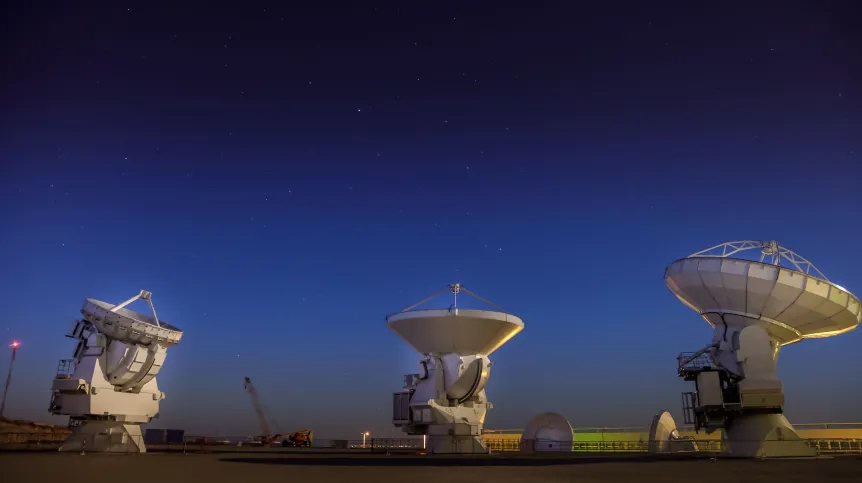
Type Ic supernovae carry within them a dramatic story of a relationship between a pair of stars. An international team of scientists led by Polish researchers has proven that for this type of cosmic explosion to occur, a not-so-peaceful - by human relationship standards - binary star system is needed.
A good script for a Hollywood melodrama could be written based on the history of these stars. Two stars find each other during a cosmic journey and begin to attract each other more and more. For some time, they get closer to each other in a dance and form a tight duet. Over time, however, it turns out that the relationship is not so well-balanced: one of the stars feeds on the other, devouring its outer layers - the hydrogen and helium envelope. However, the one being eaten will not allow all its strength to be sucked out. In the final stage of its life it explodes, presenting itself in all its glory as a supernova. The shock wave accompanying the explosion throws the greedy partner into space with enormous force. And the explosive heroine ends up as a neutron star or a black hole. And so comes the spectacular end of this troubled relationship.
The latest research by Marcin Solar and his team, published in Nature Communications, shows that this evolutionary history is common for most Type Ic supernovae.
Dr. Michał Michałowski from the Adam Mickiewicz University tells PAP that supernovae, or cosmic explosions, can have different characteristics. The main division of supernovae is based on their spectral differences. And the spectrum (light from a given object passed through a prism) contains information about the elements present in supernovae.
For example, almost no hydrogen and helium are visible in the spectra of Type Ic supernovae. The conversion of hydrogen into helium is the basic source of star energy. How is it possible that these two elements present in the outer layers of a star - disappear before the supernova explosion?
Dr. Michałowski says that a star usually needs a few to several dozen million years to consume its hydrogen reserves. So if these light elements are not present around Type Ic supernovae, it was assumed that the stars may have managed to push them away before the explosion. And that would also mean that the exploding star is very large - because only very large stars are energetic enough to push away the outer hydrogen and helium envelopes.
A binary system of interacting stars. Type Ic supernova explosions originate from such systems. Source: ESO/M. Kornmesser/S.E. de Mink
The researchers decided to test this hypothesis. They measured and compared the properties of gases surrounding supernova remnants. It turned out that in this respect, Type Ic supernovae were very similar to other, better known supernovae - Type II. And it is already known that those were created in the explosion of stars 8–15 times bigger than the Sun (i.e. not very big and not very old).
After taking these data into account, the models show that stars exploding as Type Ic and II supernovae have similar lifetimes and similar masses. They cannot therefore be massive stars. 'I was surprised by this result, because I expected that Type Ic supernovae would turn out to be supermassive stars', says Dr. Michałowski.
If the star itself did not have time to use up its fuel, what could have happened to its hydrogen and helium? It is possible that something took it away. What could do that? Probably a neighbouring star, because binary star systems are not unusual in space. Hence the conclusion that the outer layers of the star - hydrogen and helium - disappear because they were taken away by the companion star. When the star, deprived of its envelope, finally explodes, we can observe it as a Type Ic supernova. 'The second star from the system usually survives this explosion, at most it will lose its outer shell, be pushed away and become a single star again' says Dr. Michałowski.
The scientists analysed data from about 60 Type Ic supernovae and came to the conclusion that the explosion of a massive star could be a possible explanation only in a small percentage of such stars.
Supernova research is important because it is in the extreme conditions accompanying cosmic explosions that heavy elements are created. These elements made the emergence of life possible (or easier). During the explosion, this matter is dispersed in all directions. And then it can form new stars and planets.
'The evolution of a star depends on many parameters. Its fate depends on the environment in which it exists. And we want to learn about these differences', says Dr. Michałowski
The team used the world's largest telescope array, the Atacama Large Millimeter Array, located at an altitude of 5,000 meters above sea level in northern Chile. They observed the emission of a carbon monoxide line, which was used to measure the amount of molecular hydrogen at the sites of various supernova explosions.
PAP - Science in Poland, Ludwika Tomala
lt/ agt/ kap/
tr. RL













